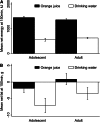Orange juice limits postprandial fat oxidation after breakfast in normal-weight adolescents and adults
- PMID: 22798004
- PMCID: PMC3649737
- DOI: 10.3945/an.112.001990
Orange juice limits postprandial fat oxidation after breakfast in normal-weight adolescents and adults
Abstract
Caloric beverages may promote weight gain by simultaneously increasing total energy intake and limiting fat oxidation. During moderate intensity exercise, caloric beverage intake depresses fat oxidation by 25% or more. This randomized crossover study describes the impact of having a caloric beverage with a typical meal on fat oxidation under resting conditions. On 2 separate days, healthy normal-weight adolescents (n = 7) and adults (n = 10) consumed the same breakfast with either orange juice or drinking water and sat at rest for 3 h after breakfast. The meal paired with orange juice was 882 kJ (210 kcal) higher than the meal paired with drinking water. Both meals contained the same amount of fat (12 g). For both age groups, both meals resulted in a net positive energy balance 150 min after breakfast. Resting fat oxidation 150 min after breakfast was significantly lower after breakfast with orange juice, however. The results suggest that, independent of a state of energy excess, when individuals have a caloric beverage instead of drinking water with a meal, they are less likely to oxidize the amount of fat consumed in the meal before their next meal.
Conflict of interest statement
Author disclosures: J. D. Stookey has received unrestricted funds for research from Nestec Ltd. J. Hamer, G. Espinoza, A. Higa, V. Ng, L. Tinajero-Deck, P. J. Havel, no conflicts of interest. The contents of this article are solely the responsibility of the authors and do not necessarily represent the official views of the National Institutes of Health.
Figures

Similar articles
-
Postprandial Glycemic and Insulinemic Responses to Common Breakfast Beverages Consumed with a Standard Meal in Adults Who Are Overweight and Obese.Nutrients. 2017 Jan 4;9(1):32. doi: 10.3390/nu9010032. Nutrients. 2017. PMID: 28054966 Free PMC article. Clinical Trial.
-
Caloric beverages consumed freely at meal-time add calories to an ad libitum meal.Appetite. 2013 Jun;65:75-82. doi: 10.1016/j.appet.2013.01.023. Epub 2013 Feb 10. Appetite. 2013. PMID: 23402713 Clinical Trial.
-
Does the consumption of caloric and non-caloric beverages with a meal affect energy intake?Appetite. 2005 Apr;44(2):187-93. doi: 10.1016/j.appet.2004.11.003. Appetite. 2005. PMID: 15808893
-
Addition of Orange Pomace to Orange Juice Attenuates the Increases in Peak Glucose and Insulin Concentrations after Sequential Meal Ingestion in Men with Elevated Cardiometabolic Risk.J Nutr. 2016 Jun;146(6):1197-203. doi: 10.3945/jn.115.226001. Epub 2016 May 11. J Nutr. 2016. PMID: 27170728 Clinical Trial.
-
High orange juice consumption with or in-between three meals a day differently affects energy balance in healthy subjects.Nutr Diabetes. 2018 Apr 25;8(1):19. doi: 10.1038/s41387-018-0031-3. Nutr Diabetes. 2018. PMID: 29695707 Free PMC article. Clinical Trial.
Cited by
-
Orange juice with a high-fat meal prolongs postprandial lipemia in apparently healthy overweight/obese women.Arch Endocrinol Metab. 2017 May-Jun;61(3):263-268. doi: 10.1590/2359-3997000000229. Epub 2016 Nov 24. Arch Endocrinol Metab. 2017. PMID: 27901186 Free PMC article. Clinical Trial.
-
Qualitative and/or quantitative drinking water recommendations for pediatric obesity treatment.J Obes Weight Loss Ther. 2014 Oct 11;4(4):232. doi: 10.4172/2165-7904.1000232. J Obes Weight Loss Ther. 2014. PMID: 25632375 Free PMC article.
-
Introduction: second forum on childhood obesity interventions.Adv Nutr. 2012 Jul 1;3(4):594S-595S. doi: 10.3945/an.112.001982. Adv Nutr. 2012. PMID: 22797998 Free PMC article. No abstract available.
-
Risks of misinterpretation in the evaluation of the effect of fruit-based drinks in postprandial studies.Gastroenterol Res Pract. 2014;2014:870547. doi: 10.1155/2014/870547. Epub 2014 Dec 25. Gastroenterol Res Pract. 2014. PMID: 25610461 Free PMC article. Review.
-
Negative, Null and Beneficial Effects of Drinking Water on Energy Intake, Energy Expenditure, Fat Oxidation and Weight Change in Randomized Trials: A Qualitative Review.Nutrients. 2016 Jan 2;8(1):19. doi: 10.3390/nu8010019. Nutrients. 2016. PMID: 26729162 Free PMC article. Review.
References
-
- Ludwig DS, Peterson KE, Gortmaker SL. Relation between consumption of sugar-sweetened drinks and childhood obesity: a prospective, observational analysis. Lancet. 2001;357:505–8 - PubMed
-
- Harrington S. The role of sugar-sweetened beverage consumption in adolescent obesity: a review of the literature. J Sch Nurs. 2008;24:3–12 - PubMed
-
- Nielsen SJ, Popkin BM. Changes in beverage intake between 1977 and 2001. Am J Prev Med. 2004;27:205–10 - PubMed
-
- Ogden CL, Flegal KM, Carroll MD, Johnson CL. Prevalence and trends in overweight among US children and adolescents, 1999–2000. JAMA. 2002;288:1728–32 - PubMed

